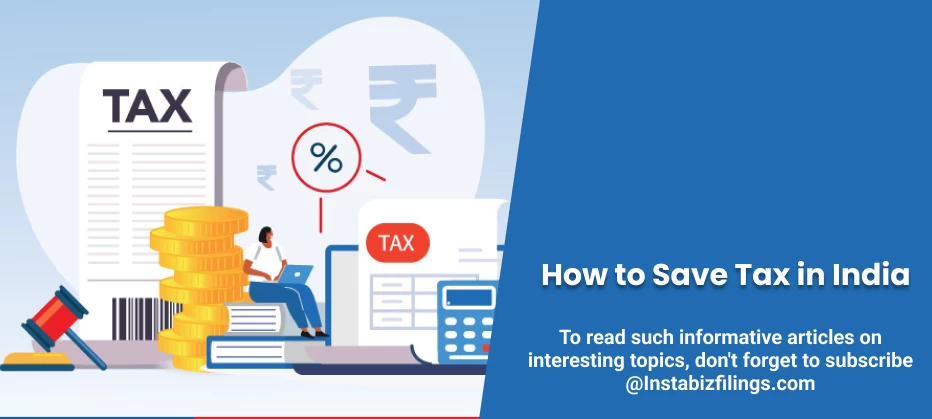
How to Save Tax in India
July 31, 2024 by Team Instabizfilings
The revenue generated from such taxes, including property taxes, is essential for smooth running in the country, as the revenue raised is applied by the government to aid economic development. The tax is also subject to change according to the respective individual incomes as defined by the tax slab in India.
Income taxpayers are always on the lookout for opportunities to save tax and reduce their overall tax liability.
With the deadline for filing an ITR drawing near, many search for tax-saving investment options to save income tax in India. This is quite natural as no one wants to miss out on a valid income tax-saving option that will reduce their tax payable amounts. There are numerous legal ways to save tax under the Income Tax Act of 1961, including tax-saving mutual funds, NPS, insurance premiums, medical insurance, home loans, and others.
Regardless of whether you are a salaried individual, a freelancer, a business owner, or earn income from your investments, you are required to pay taxes to the government as per the Income Tax Act within the specified timeframe.
List of Tax-Saving Options for Different Sections
|
Section |
Investments |
Exemption Limit |
|
80C |
Investments in PPF, PF, insurance, NPS, ELSS, etc. |
150,000 |
|
80CCD |
NPS investments |
50,000 |
|
80D |
Investment in medical insurance for self or parents |
25,000/50,000 |
|
80EE |
Interest on Home loan |
50,000 |
|
80EEA |
Interest on Home loan |
1,50,000 |
|
80EEB |
Interest on electric vehicle loan |
1,50,000 |
|
80E |
Interest in education loan |
Full amount |
|
24 |
Interest paid on the home loan |
200,000 |
|
10(13A) |
House Rent Allowance (HRA) |
As per the salary structure |
Section 80C
- Section 80C is a popular and important provision related to taxes, which helps save taxes for individuals as well as Hindu Undivided Families (HUFs) in India. It allows deductions based on a number of investments, with a maximum limit of Rs. 1.5 lakh.
- The objective of Section 80C is to promote savings and investments by exempting from tax any interest paid or received on money lent to individuals in India. Additionally, this section allows a deduction at source for an amount equivalent to 10% of the total interest payable under section 8 of the Income Tax Act 1961.
- Section 80 of the Act outlines the conditions under which interest can be deducted at source. Once these criteria are fulfilled, you can claim a deduction of up to 10%. If you are paying interest on loans provided to Indian resident borrowers, you can claim this deduction at source.
Equity Linked Savings Scheme (ELSS)
- ELSS mutual fund scheme has a 3-year lock-in period. ELSS mutual fund scheme is the only mutual fund scheme in India that allows tax deductions under section 80C of the Indian Income Tax Act.
- Such funds result in greater returns than other savings options as the investment in equity takes place. An investor can either invest the whole amount at once as well as through the SIP route. In this investment plan, one must keep in mind that the funds cannot be withdrawn before completion of the 3-year lock-in period.
- One should take into account the risk involved in ELSS as the investments are made in the stock market. With the possibilities of market fluctuations associated with it, there are chances of reaping major advantages.
Public Provident Fund (PPF)
- The Public Provident Fund has a maturity period of 15 years. It is a popular long-term savings scheme that helps save taxes. The interest rate for the PPF account is changed every quarter. According to the latest updates, the current interest rate for the PPF account is 7.1%.
- The interest generated on PPF is exempt from taxes. One can open a PPF account with an initial minimum payment of Rs. 500, and the annual maximum limit is Rs. 1.5 lakh.
National Savings Certificate (NSC)
- Another good option for availing income tax exemption is the National Savings Certificate, which carries a fixed interest rate of 7.7% per annum and a tenure of 5 years.
- Interest from NSC is available for tax-saving, and thus an amount up to Rs. 1.5 lakh can be claimed as a deduction under Sec 80C.
Tax-Saver FDs
- Tax-saving FDs are also one of the effective ways to save on income tax. Under 5-year tax-saver FDs, investors may get a tax deduction up to Rs. 1.5 lakh. However, these come with a fixed interest rate, between 7-8% currently, while the interest earned is taxable and will be charged according to the investor's tax slab.
Senior Citizens Savings Scheme (SCSS)
- Senior Citizen Savings Scheme: This is a long-term tax-saving investment option that has a term of 5 years, and it can only be availed by people above 60 years. Its interest rate stands at 8.2% (taxable). According to this plan, you can avail a tax exemption of up to Rs. 1.5 lakh.
Sukanya Samriddhi Yojana (SSY)
- The Sukanya Samriddhi Yojana is beneficial for parents with a girl child below 10 years. Investments made towards this scheme are eligible for a tax deduction of up to Rs. 1.5 lakh under Section 80C. The account has a tenure of 21 years or until the girl's marriage after she turns 18.
- The current interest rate for this scheme is 8.00%, and the interest earned is tax-free.
- The Employee Provident Fund is a retirement benefits scheme primarily for salaried employees. Under the EPF Act, employers deduct 12% of the basic salary and Dearness Allowance (DA), which is then deposited into government-recognized provident fund schemes.
- EPF is one of the common tax-saving schemes, with the deduction contributing towards the Rs. 1.5 lakh limit under Section 80C.
Home Loan Repayment
- Individuals who have taken a home loan can claim tax deductions under Section 80C for the portion of the EMI used to repay the principal amount. However, the interest component of the EMI does not qualify for tax deductions.
Tuition Fees
- This income tax saving benefit is available exclusively to individual parents or guardians with up to two children per individual. Tax deductions of up to Rs. 1.5 lakh can be claimed for tuition fees paid for a child’s education. The deduction is not dependent on the child’s class but is applicable only if the education course is full-time and conducted by an Indian school, college, or university.
- The benefits of this scheme can be claimed by parents who have adopted children, are unmarried individuals, or are divorced parents.
A Few Tips - How To Save Taxes in India
- When considering reducing taxable income, several key sections under the Income Tax Act offer tax-saving opportunities. These include Sections 80C, 80CCC, 80CCD, 80D, 80DD, 80DDB, 80CCG, and 80G.
- Listed below are the sections and their respective exemption limits. For salaried individuals, taking advantage of these sections can be particularly beneficial.
- However, it's important to note that while these exemptions can help, they may not cover all your basic needs and expenses.
- Understanding these allowances and exemptions is crucial when planning your finances.
There are numerous tips for saving taxes in India.
- One tip is to avoid purchasing gold and other precious metals, as they are taxed at a high rate and do not generate significant income.
- Another tax-saving strategy is to ensure you possess a valid PAN card. Obtaining a PAN card is straightforward, but it should be done correctly. You should contact the Income Tax Department directly for assistance.
- You can also save money by utilizing your deductions effectively and claiming them on your tax returns. For instance, if you paid for your child’s education, you should claim this expense as a tax deduction.
Tax Saving Options Other than Section 80C
- How to save income tax beyond Section 80C is a common question that taxpayers often seek answers to. There are various deductions available under Section 80, apart from 80C, that can be utilized to reduce income tax liability. For example, tax benefits on health insurance premiums and home loan interest are significant examples.
Listed below are such provisions:
-
You can deduct a maximum of Rs.25,000 (Rs.50,000 in the case of Senior Citizens) on insurance premiums relating to medical schemes.
-
Under Section 80EE, a deduction of up to Rs. 50,000 is allowed on the home loan interest paid.
-
Contributions made to the National Pension System (NPS) are eligible for a tax deduction of up to Rs. 1.5 lakh under Section 80CCD.
-
Under Section 80E, you are eligible to claim a deduction for the interest paid on educational loans.
-
Contributions made to specific institutions/funds are tax deductible under Section 80G.
-
The exemption from capital gains tax is provided under Sections 54 to 54F
-
Interest paid towards a car loan for buying an electric car can be set off by availing the section 80EEB benefit.
-
Interest earned from a savings bank account of a maximum of Rs. 10,000 is deductible under section 80TTA.
Disclaimer
The information provided in this blog is purely for general informational purposes only. While every effort has been made to ensure the accuracy, reliability and completeness of the content presented, we make no representations or warranties of any kind, express or implied, for the same.
We expressly disclaim any and all liability for any loss, damage or injury arising from or in connection with the use of or reliance on this information. This includes, but is not limited to, any direct, indirect, incidental, consequential or punitive damage.
Further, we reserve the right to make changes to the content at any time without prior notice. For specific advice tailored to your situation, we request you to get in touch with us.


